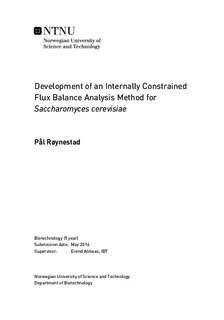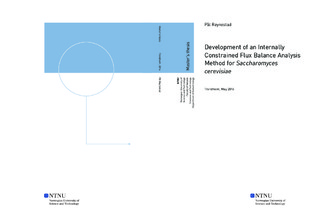| dc.description.abstract | One of the most successful applications of the principles of systems biology has been the development of genome-scale metabolic models (GSMs). GSMs are models where every known metabolic reaction taking place in a cell is included, and allow in silico simulation of cellular behavior. This is a rapidly expanding field where new methods and models are constantly being developed and published. The most advanced GSMs incorporate both enzyme kinetics and gene expression, but so far this has been limited to Escherichia coli.
This thesis introduces a method that extends a GSM of Saccharomyces cerevisiae by incorporating enzyme kinetics to constrain the the permissible metabolic states. This was done by simplifying existing methods developed for E. coli. This method is called InteRnally Constrained Flux Balance Analysis (ircFBA), and methods were also developed for the automated retrieval and categorization of kinetic data from publicly accessible databases to enable construction of ircFBA models for other GSMs. The growth rate predictions produced by ircFBA were shown to correlate well with experimental measurements of S. cerevisiae in minimal media with glucose as the only carbon and energy source.
Two algorithms were developed to enhance the performance of ircFBA by altering the kinetic parameters. These were based on two different aspects of mathematical programming. The first introduces dummy variables into the ircFBA problem to simulate the effect of altering kinetic parameters during growth rate simulation. The other searches for minimal changes to the kinetic parameters in order to reach a higher growth rate. The first algorithm succeeded in closing growth gaps, but was numerically unstable and difficult to work with. The second algorithm, however, was demonstrated to be able to close the gap between ircFBA and experimental growth rates for aerobic glucose-limited growth by making changes to the kinetic parameters of at most six reactions.
The motivation for developing these algorithms was to use them to create strain-specific GSMs for S. cerevisiae in order to model strains used in wine production. Both algorithms were demonstrated to be able to close growth rate gaps, but only the second one could do it reliably and without making global changes to the model. It therefore has the potential to realize this ambition. | |

